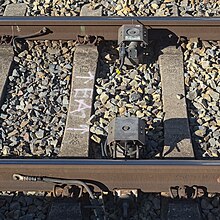

Automatic track warning system (ATWS, German: Rottenwarnanlage) is a technical device used during track construction for occupational safety. It warns the construction site workers of an approaching train. In Germany, it usually consists of a series of signal lights and acoustic warning devices, which are mounted on steel poles or tripods at the edge of the track bed every 30 meters. There are wired and wireless systems that are automatically activated when a train approaches, for example by a wheel contact in the track bed. As long as the ATWS is generating warning signals, the construction site personnel must stay away from the track in question and allow the train to pass. ATWS is considered safer than the non-automated solution, where one worker constantly watches for approaching trains and alerts his colleagues.
Types

There are collective ATWS and individual ATWS. The collective ATWS generates an acoustic signal for a group of workers. The individual ATWS is a wearable device warning every worker individually.
Acoustic warning signals in Germany
Acoustic signals generated by collective ATWS in Germany are defined in the railway signalling regulations:
- A long continuous tone (mixed sound of different high tones) means "Caution! Vehicles are approaching on the neighbouring track"
- Two long tones in succession at different pitches signal "Clear the working track!"
- At least five times two short tones at different pitches signalling "Clear working tracks as quickly as possible!"
After the acoustic signal, the railway workers have 25 seconds to escape from the track.
Noise pollution controversy for collective ATWS
Due to the nature of the system, ATWS is very loud (97 up to 126 dB) so that it can be heard by the track workers to be warned, even in the vicinity of loud working machines and with hearing protection in place. This is a burden for people living near railway tracks during work. Modern systems adapt to the ambient volume (mandatory from 2019) and only warn at full sound pressure in very loud environments. Even at reduced volume, this is still perceived as noise pollution. In 2014 in Stuttgart-Sommerrain, an ATWS was sabotaged by unidentified persons.
Research on wearable devices for personal warning
EU Commission funded the project ALARP (A railway automatic track warning system based on distributed personal mobile terminals) in the years 2010–2013 by the total amount of €3,941,877.20. The aim of the project was to improve the safety of track workers through the development of an innovative ATWS using low-cost, rugged, wireless wearable devices.
See also
References
- Seminatore, Antonio Andrea; Ghelardoni, Luca; Ceccarelli, Andrea; Falai, Lorenzo; Schultheis, Michael; Malinowsky, Boris (2012). "ALARP (A Railway Automatic Track Warning System Based on Distributed Personal Mobile Terminals)". Procedia - Social and Behavioral Sciences. 48: 2081–2090. doi:10.1016/j.sbspro.2012.06.1181.
- ^ Tageblatt, Göttinger Tageblatt / Eichsfelder (8 September 2018). "Schrille Warnsignale der Bahn nerven Anwohner in Göttingen gewaltig Rottewarnanlagen sollen Bauarbeiter sichern". www.goettinger-tageblatt.de (in German). Retrieved 3 March 2024.
- N, Noorudheen; M, McClanachan; Y, Toft (2012). "Track worker safety: investigating the contributing factors and technology solutions". CORE 2012, Rail - the core of integrated transport, conference on railway engineering.
- Juliane Manteuffel; Dr. Peter Bärenz (2012). "Beurteilung des Einsatzes der individuellen Warnung für bestimmte Arbeitsstellen im bzw. am Gleisbereich – insbesondere unter Berücksichtigung der Trageakzeptanz von individuellen Warngeräten" (PDF). Forschungsgesellschaft für angewandte Systemsicherheit und Arbeitsmedizin. (in German). Retrieved 3 March 2024.
- ^ Germany. "Rottenwarnanlage sabotiert: Gleisarbeiter in Lebensgefahr". schwarzwaelder-bote.de (in German). Schwarzwälder Bote, Oberndorf. Retrieved 3 March 2024.
- "Periodic Report Summary - ALARP (A railway automatic track warning system based on distributed personal mobile terminals) | FP7". CORDIS | European Commission. Retrieved 3 March 2024.